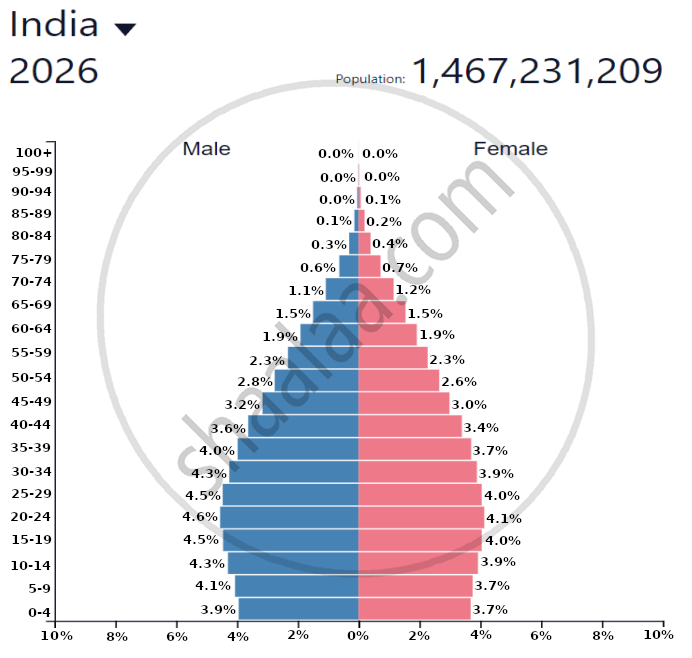Advertisements
Advertisements
What was unique about the social reform movements of the 19th century?
Concept: Social Reform Movements in the 19th and Early 20th Century
| Table 3: The Declining Sex-ratio in India, 1901-2011 | ||||
| Year |
Sex ratio (all age groups) |
Variation over the previous decade | Child Sex ratio (0-6 years) | Variation over the previous decade |
| 1901 | 972 | - | - | - |
| 1911 | 964 | -8 | - | - |
| 1921 | 955 | -9 | - | - |
| 1931 | 950 | -5 | - | - |
| 1941 | 945 | -5 | - | - |
| 1951 | 946 | +1 | - | - |
| 1961 | 941 | -5 | 976 | - |
| 1971 | 930 | -11 | 964 | -12 |
| 1981 | 934 | +4 | 962 | -2 |
| 1991 | 927 | -7 | 945 | -17 |
| 2001 | 933 | +6 | 927 | -18 |
| 2011 | 943 | +10 | 919 | -8 |
| Note: The sex ratio is defined as the number of females per 1000 males; Data on age-specific sex ratios are not available before 1961. |
||||
- Give reasons for the declining sex ratio.
- In your opinion, what steps should be taken to deal with this bias against the girl-child?
Concept: Some Theories and Concepts in Demography
Read the source and answer the question:
| Ways of thinking ........ John Stuart Mill's essay 'On Liberty' soon after its publication became a text in Indian colleges. Indians came to know about Magna Carta and the struggle for liberty and equality in Europe and America. |
Mention the kind of Westernization being referred to in the given source.
Concept: Different Kinds of Social Change
"Sanskritisation seems to justify a model that rests on inequality and exclusion." Give two reasons to support this statement.
Concept: Different Kinds of Social Change
The varied social reform movements did have common themes. Yet there were also significant differences. State any two differences.
Concept: Social Reform Movements in the 19th and Early 20th Century
The measure of comparing the portion of a population which is composed of dependents with the portion that is the working population is______.
Concept: Some Theories and Concepts in Demography
Explain the two types of Demography.
Concept: Introduction to the Demographic Structure of the Indian Society
Explain the phenomenon of Modernity as given by Rudolph and Rudolph.
Concept: Different Kinds of Social Change
Sanskritisation seems to justify a model that rests on inequality and exclusion. Explain this model.
Concept: Different Kinds of Social Change
Which of the following statements is true in the scenario of high fertility rate?
Concept: Some Theories and Concepts in Demography
The women's question arose in modem India as part of 19th century middle class social reform movements. These reformers used a mix of ideas. Explain these ideas.
Concept: Social Reform Movements in the 19th and Early 20th Century
Malthus's theory of population growth was a rather pessimistic one. It was challenged by theorists."Justify the statement.
Concept: Some Theories and Concepts in Demography
"Sometimes the city may be preferred for social reasons." Enumerate these social reasons.
Concept: Rural-urban Differences
Which of the following stages, as per the Theory of Demographic Transition, is that of high population growth?
Concept: Some Theories and Concepts in Demography
“Considering from an urban point of view, the rapid growth in urbanization shows that the town or city has been acting as a magnet for the rural population.” Choose the incorrect statement about urbanization in India?
Concept: Rural-urban Differences
Assertion (A): The impact of Sanskritisation is many sided.
Reason (R): Its influence can be seen in language, literature, ideology, music, dance, drama, style of life and ritual.
Concept: Different Kinds of Social Change
City offers relative anonymity to those migrating to it. What do you mean by relative anonymity?
Concept: Rural-urban Differences


Based on the given Population Pyramids of India for the year 2026 and 2050, answer the following questions.
- What is demographic dividend?
- What do you infer, on comparing the given graphics for the age group of 55-59 and 60-64
- What, according to you, are the implications of this inference?
Concept: Age Structure of the Indian Population
Kumudtai’s journey into Sanskrit began with great interest and eagerness with Gokhale Guruji, her teacher at school… At the University, the Head of the Department was a well-known scholar and he took great pleasure in taunting Kumudtai…Despite the adverse comments she successfully completed her Masters in Sanskrit…. Source: Kumud Pawade (1938)
What does Kumud Pawade’s autobiography show us about the relation between gender and caste?
Concept: Different Kinds of Social Change
What are the factors behind the assertion of tribal identities today?
Concept: Tribal Communities
